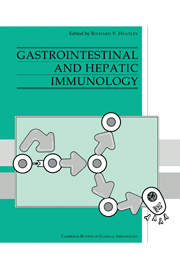Book contents
- Frontmatter
- Contents
- List of contributors
- Preface
- 1 Lymphoid cells and tissues of the gastrointestinal tract
- 2 Lymphocyte migration to the gut mucosa
- 3 Regulating factors affecting gut mucosal defence
- 4 Gastritis
- 5 The immunology of coeliac disease
- 6 Inflammatory bowel disease
- 7 Food intolerance and allergy
- 8 Gastrointestinal and liver involvement in primary immunodeficiency
- 9 Secondary immunodeficiency – the acquired immunodeficiency syndrome (AIDS)
- 10 Intestinal infections
- 11 Lymphomas
- 12 Small bowel transplantation
- 13 Clinical aspects of immunologically mediated intestinal diseases
- 14 Chronic active hepatitis
- 15 Primary biliary cirrhosis
- 16 Immunology and immunopathology of acute viral hepatitis
- 17 Immunology of liver transplantation
- 18 Clinical correlates with hepatic diseases
- Index
2 - Lymphocyte migration to the gut mucosa
Published online by Cambridge University Press: 03 February 2010
- Frontmatter
- Contents
- List of contributors
- Preface
- 1 Lymphoid cells and tissues of the gastrointestinal tract
- 2 Lymphocyte migration to the gut mucosa
- 3 Regulating factors affecting gut mucosal defence
- 4 Gastritis
- 5 The immunology of coeliac disease
- 6 Inflammatory bowel disease
- 7 Food intolerance and allergy
- 8 Gastrointestinal and liver involvement in primary immunodeficiency
- 9 Secondary immunodeficiency – the acquired immunodeficiency syndrome (AIDS)
- 10 Intestinal infections
- 11 Lymphomas
- 12 Small bowel transplantation
- 13 Clinical aspects of immunologically mediated intestinal diseases
- 14 Chronic active hepatitis
- 15 Primary biliary cirrhosis
- 16 Immunology and immunopathology of acute viral hepatitis
- 17 Immunology of liver transplantation
- 18 Clinical correlates with hepatic diseases
- Index
Summary
Introduction
Populations of T and B cells in the lymphoid compartments of the intestine are continuously remodelled by selective migration of lymphocytes. Although many aspects of this migration have been well reviewed elsewhere (Reynolds, 1988; Ottaway, 1990; Salmi & Jalkanen, 1991; Picker & Butcher, 1992; Ottaway & Husband, 1992), there have been rapid changes recently in our understanding of these processes, especially as they apply to the human intestine. The purposes of this chapter are to provide a brief overview of the physiological basis of lymphocyte migration in the intestine, to highlight some emerging concepts of its regulation at the cellular and molecular level and to examine aspects of these processes that relate to our understanding of immune and inflammatory events in the intestine.
Physiology of lymphocyte migration to the intestine
A substantial proportion of the 1011 to 1012 lymphocytes that exit the thoracic duct to enter the subclavian vein each day (Pabst, 1988), will have passed through the intestine. Three distinct lymphoid domains are present in the intestine (Fig. 2.1). The aggregated gut associated lymphoid tissues (GALT) include the Peyer's patches (PP), the appendix, the lymphoid nodules of the colon, the rectum and the pharynx. In response to luminal antigen, the GALT tissues generate activated B and T cells which can populate the effector lymphoid domains of the mucosa (Brandtzaeg et al., 1991). The mucosal effector compartments include the epithelial layer, where intraepithelial lymphocytes (IEL) are interposed between approximately every fifth to fifteenth epithelial cell (Cerf–Bensussan & Guy–Grand, 1991) and the lamina propria, the volume of which is up to 50% lymphoid (Lee, Schiller & Fordtran, 1988).
- Type
- Chapter
- Information
- Gastrointestinal and Hepatic Immunology , pp. 24 - 47Publisher: Cambridge University PressPrint publication year: 1994
- 2
- Cited by



